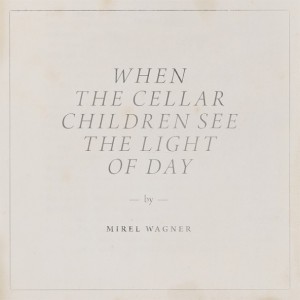… it still defines Mirel Wagner’s music perfectly. It certainly applied to her self-titled debut, which brought folk and blues back to their eldritch roots with songs that fell somewhere between nursery rhymes, fairy tales, and murder ballads. It’s an even more apt description of her intensely beautiful and unsettling second album, When the Cellar Children See the Light of Day.
Wagner collaborated with Finnish producer Sasu Ripatti, best known for his work as Luomo and Vladislav Delay; not an obvious choice, considering that his music is largely electronic. However, Ripatti honors her songs by giving them the cleanest, clearest surroundings possible, highlighting her hypnotic fingerpicking on „Dreamt of a Wave“ and „The Devil’s Tongue.“
Perhaps even more so than on her debut, When the Cellar Children’s spaces are as eloquent as the music, while subtle effects and slightly fuller instrumentation hover between real and surreal as needed. When the spectral backing vocals float up on „Oak Tree,“ a song about an abandoned child who ends up „dreaming underneath,“ it’s spine-tingling. Aptly, the motif of buried children runs through the album, but When the Cellar Children See the Light of Day is more about revealing than rescuing. Freedom usually means death, as on „The Dirt,“ where a child is ready to „close my eyes and wake up to a new life.“
This poetic simplicity makes Wagner’s storytelling all the more poignant and often horrifying; as with her playing, she implies a wealth of nuances in seemingly direct phrases. „In My Father’s House“ paints a portrait of deceptive serenity as Wagner details a household so full of suppressed terror that even „the pictures on the wall never look into your eyes“ over velvety strumming. On „Taller Than Tall Trees,“ she distills an ambivalent love story filled with an album’s worth of emotional twists and turns in its opening words: „See a girl dressed as a woman/Here’s a man who lies.“
Wagner (and Ripatti)’s technical prowess only enhances the album’s emotional impact. Where Mirel Wagner was a collection of vignettes, these songs revolve around the terrible things people do in the name of love, whether it’s „What Love Looks Like“’s bitter recriminations, „Goodnight“’s murder lullaby, or the eerily matter-of-fact opener „1 2 3 4,“ where a child killer professes to have „a big big heart and lots of love.“ As accomplished as it is disturbing, When the Cellar Children See the Light of Day is a riveting album from a formidable and yes, haunting, talent.
– Heather Phares, allmusic
„I’ve had a quiet day, I’ve listened to this album over and over. The stories never reach out for false consolation, the things told are nearly as bitter as the the things not told. The calmness of the voice is an exercise not to lose the voice at all. The slow motion simply suggests that some day the terror is over. Luck is a luxury. And victims everywhere. Your comfort zone is samsara. Naked music.“ (m.e.)
